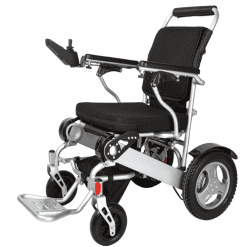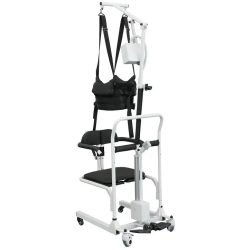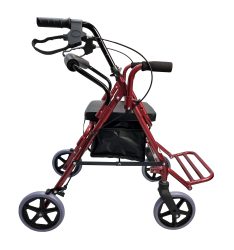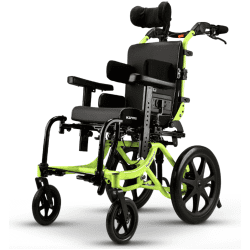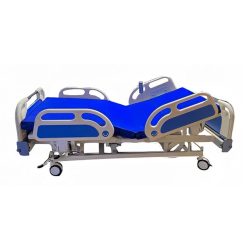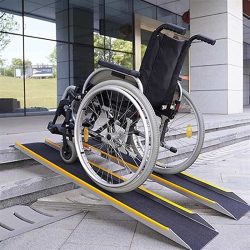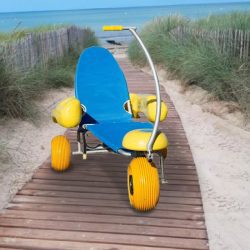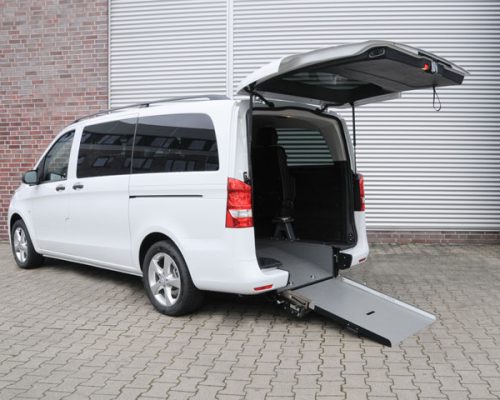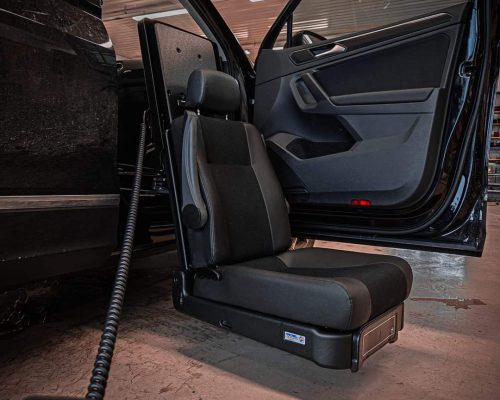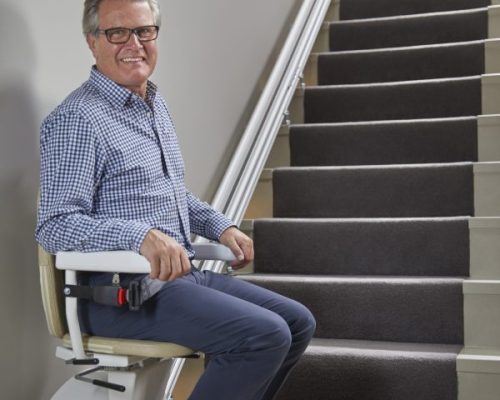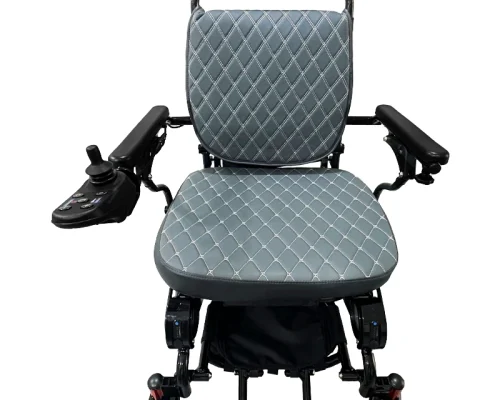Table of Contents
ToggleDid you know that there are different types of wheelchairs specifically designed to cater to different mobility needs? If you’re someone who uses a wheelchair or knows someone who does, you might have come across the terms ramp wheelchair and step wheelchair.
While both serve the same purpose of assisting users in their daily movements, there are some significant differences between them. In this blog post, we’ll explain what is the difference between a ramp wheelchair and a step wheelchair. It will provide you with valuable insights. So, let’s get started!
What Is A Ramp Wheelchair?
A ramp wheelchair, quite simply, is a vital mobility device designed to provide freedom and accessibility to those with physical disabilities. It’s more than just a chair; it’s a key to independence and inclusion.

Imagine a world where navigating your surroundings was seamless, regardless of obstacles or uneven terrain. That’s the promise a ramp wheelchair fulfills.
At its core, a ramp wheelchair shares similarities with a standard one. It boasts a seat, backrest, armrests, and, most notably, wheels. Yet, the real distinction lies in the wheels and features tailored to surmount ramps and inclines. These wheels are engineered for superior traction and stability, facilitating smooth mobility across various surfaces.
The design of a ramp wheelchair is the result of careful engineering. While conventional wheelchairs are mainly optimized for flat surfaces, ramp wheelchairs are outfitted to tackle inclines and rugged terrains.
These wheels are often larger, providing improved stability and grip on uneven surfaces. They’re the driving force behind the chair’s ability to glide across ramps, curbs, and outdoor environments easily.
However, not just the wheels set a ramp wheelchair apart. It features a reinforced frame, which offers added strength and durability. This robust construction ensures the wheelchair remains stable under increased stress, making it a dependable choice for daily life.
One of the standout features of a ramp wheelchair is its adaptability. It’s not a one-size-fits-all solution; rather, it can be tailored to meet the unique needs of each user. Many models offer adjustable settings, enabling users to personalize their chairs for the utmost comfort and efficiency.
These adjustments may include modifying the seat height, repositioning the backrest, or altering the angle of the wheels. This versatility empowers users to find their ideal configuration for navigating their environment.
Ramp wheelchairs aren’t limited to conquering a single type of incline. They’re designed to handle a variety of ramps and slopes, from gradual inclines to steeper gradients.
For instance, curb ramps at street corners provide a seamless transition from sidewalks to roads. A ramp wheelchair effortlessly manages this transition, ensuring users can move smoothly through urban settings.
In indoor environments, where stairs or elevated platforms are common, ramps inside buildings offer an accessible alternative. A ramp wheelchair excels in these situations, allowing individuals to access upper floors or different building sections without needing a lift or elevator.
Beyond cityscapes, ramp wheelchairs empower outdoor exploration. Parks, hiking trails, and nature reserves become accessible to individuals who might otherwise struggle with uneven terrain.
Because of their rugged design, these wheelchairs open up a world of outdoor activities, promoting physical fitness and a deeper connection with nature.
What Is A Step Wheelchair?
When it comes to mobility aids, wheelchairs are at the top of the list. However, not all people with mobility impairments can operate a traditional wheelchair, especially those who have lost control of their upper body or have weak upper extremities. This is where a step wheelchair comes in handy.
A step wheelchair is a type of mobility aid designed for people with lower body paralysis or weakness. It is controlled by pushing footplates with the feet rather than using the hands to control the wheels. The user steps onto and off the footplates, controlling the movement of the chair and allowing for mobility in a standing position.
The design of the step wheelchair looks similar to a traditional wheelchair, with two large rear wheels and two front casters. The most significant difference is the footplates at the bottom of the chair. These plates are where the user stands, pressing down with their feet to move the chair forward or backward.
So, how exactly does a step wheelchair work? Well, various wheelchair designs and models are available on the market, but they all follow the same basic principles. The platform is attached to the base of the wheelchair and is powered by hydraulic or electric motors. When the user presses a button or lever, the platform lifts them up into a standing position.
Once they are standing, they can perform their desired tasks or move around as necessary. When they are ready to sit back down, they simply press the button or lever again, and the platform lowers them back into a seated position.
Uses and Benefits of a Ramp Wheelchair
This type of wheelchair generally comes equipped with a built-in ramp, which allows a person in the wheelchair to move up or down the ramp to access different locations easily. The following are some of the uses and benefits of a ramp wheelchair:
1. Increased Mobility
One of the primary benefits of a ramp wheelchair is increased mobility. Ramp wheelchairs allow people with physical disabilities to get around without assistance from others. This independence not only helps people with physical disabilities live fuller lives but it also promotes an increased sense of self-worth and dignity.
2. Ease of Access
Ramp wheelchairs enable people with mobility challenges to access places they otherwise would not be able to. For example, a building with steps or stairs becomes immediately accessible to a person using a ramp wheelchair. This increased access level helps people enjoy activities such as shopping, visiting friends, and attending public events.
3. Variety of Designs and Features
Ramp wheelchairs come in various designs and types, each with unique features suited to different needs. For instance, a foldable ramp wheelchair is great for travel. In contrast, a heavy-duty ramp wheelchair with larger wheels is ideal for outdoor use.
4. Improved Health and Well-being
Using a ramp wheelchair can help to reduce the physical stress and strain that movement can place on a person’s body. Using a wheelchair also encourages healthy habits, such as regular exercise and physical therapy, which can improve overall health and well-being.
5. Cost-Effective
Ramp wheelchairs are an affordable way to provide people with accessible transport. They are relatively cheaper compared to the cost of building ramps or lifts, and they do not require any structural modifications to a building.
6. Easy to Operate
Most ramp wheelchairs are easy to operate, even for individuals with limited hand movements or coordination. The controls are easy to reach and require minimal physical effort to work. This ease of operation makes using a ramp wheelchair practical and convenient.
Uses and Benefits of a Step Wheelchair
Step Wheelchairs have been a game-changer for individuals with mobility challenges, offering them the freedom to move around independently. Among the various types of wheelchairs available, the step wheelchair stands out as a versatile and practical choice.
1. Indoor and Outdoor Use
One of the standout benefits of step wheelchairs is their versatility. These wheelchairs are suitable for both indoor and outdoor use. Whether navigating tight spaces within your home or entering the great outdoors, a step wheelchair can handle it all.
Indoors; the compact design of step wheelchairs makes maneuvering through doorways and tight corners a breeze. You won’t have to worry about getting stuck in narrow hallways or struggling to turn around in your own living room.
Outdoors; the sturdy construction of step wheelchairs allows users to tackle various terrains, from smooth pavements to uneven surfaces like gravel or grass. This versatility ensures that users can enjoy various activities without limitations.
2. Convenient for Stair Navigation
One of the primary uses of a step wheelchair is to provide easy and safe navigation on stairs. Traditional wheelchairs are not designed to move up or down steps, which can pose significant challenges for individuals with mobility disabilities.
However, a step wheelchair has special mechanisms like a retractable set of wheels or additional stabilizers to help users easily navigate stairs. This feature makes a step wheelchair highly beneficial for individuals who live in multi-story buildings or homes with stairs.
3. Improved Cardiovascular Health
Believe it or not, using a step wheelchair can positively affect cardiovascular health. Stepping on the wheelchair’s pedals engages the lower body muscles and promotes circulation. This gentle exercise can help prevent muscle atrophy and maintain joint flexibility.
Moreover, increased circulation can positively impact overall health by reducing the risk of blood clots and pressure sores. It’s a simple yet effective way to incorporate physical activity into a daily routine, which can lead to improved well-being.
4. Compact and Portable
Another advantage of step wheelchairs is their compact and portable design. Many models are foldable, allowing for easy storage and transportation. This feature mainly benefits individuals who frequently travel or need to transport their wheelchairs in a car.
The ability to fold the wheelchair into a compact size means it can fit in the trunk of a car without taking up too much space. This convenience ensures that users can maintain mobility even when they’re away from home.
5. A Tool for Rehabilitation
For individuals recovering from injuries or surgeries, step wheelchairs can be valuable tools for rehabilitation. These wheelchairs support the gradual transition from sitting to standing, allowing users to rebuild their strength and mobility over time.
Physical therapists often incorporate step wheelchairs into rehabilitation programs to help patients regain their independence and mobility. Standing and bearing weight while safely supported by the wheelchair frame aids in the recovery process.
6. Psychological Well-Being
The psychological benefits of using a step wheelchair cannot be overstated. Shifting from a seated to a standing position can boost self-esteem and mental well-being. Users often report feeling more confident and capable when using a step wheelchair, which can positively impact their overall quality of life.
To stand up and engage with others at eye level fosters a sense of inclusion and normalcy. This can help individuals with mobility limitations overcome emotional barriers and embrace a more active and fulfilling lifestyle.
Differentiating Features of a Ramp Wheelchair and a Step Wheelchair
Here are the key differences between a ramp wheelchair and a step wheelchair to help you decide which one might be the best fit for your needs.
Ramp Wheelchair: Mastering Inclines and Uneven Terrain
Ramp wheelchairs are the go-to choice when it comes to conquering slopes inclines, and navigating rough outdoor terrain. These specialized wheelchairs are engineered to provide stability and control in situations where traditional wheelchairs might falter.
Wheel Design
One of the primary differences in a ramp wheelchair is its wheel design. These wheelchairs often feature larger rear wheels, sometimes with enhanced tread patterns. These beefed-up wheels are designed for better traction and stability on inclines and uneven surfaces. When facing a steep hill or a rough trail, these wheels can grip the terrain securely, ensuring a smooth and safe ride.
Seat Adjustability
Another feature that sets ramp wheelchairs apart is the ability to adjust the seat position. This adjustment allows users to shift their weight forward or backward. Why is this important? It’s all about maintaining balance on slopes.
By adjusting the seat position, users can distribute their weight effectively, preventing the wheelchair from tipping forward or backward when ascending or descending inclines.
Frame Construction
Ramp wheelchairs are built with durability in mind. The frames are typically robust and sturdy to withstand the added stress of navigating uneven terrain. Whether you’re tackling a rocky path or a gravel road, the frame of a ramp wheelchair can handle the challenge, providing a reliable and comfortable ride.
Anti-Tip Mechanism
Safety is a top priority for ramp wheelchairs. Many of these wheelchairs come equipped with anti-tip mechanisms. These mechanisms prevent the wheelchair from tipping backward while going up steep ramps. This added layer of safety ensures that users can confidently take on even the most challenging slopes.
Battery Capacity
To ensure uninterrupted mobility over extended periods, ramp wheelchairs often boast larger battery capacities. More power means you can tackle those lengthy outdoor adventures without worrying about running out of juice halfway through. It’s all about maintaining that freedom of movement.
Ergonomic Handles
Having a secure grip is crucial when maneuvering on steep slopes. Ramp wheelchairs typically feature ergonomically designed handles that fit comfortably in your hands. These handles provide the control you need to navigate safely and smoothly through challenging terrain.
Terrain-Specific Tires
For outdoor enthusiasts, ramp wheelchairs may come with tires specifically designed for off-road adventures. These tires often feature tread patterns that excel on various surfaces, from gravel and grass to dirt paths. With the right tires, you can explore nature’s wonders without limitations.
Foldable and Portable
Convenience is key, and many ramp wheelchairs are designed to be foldable and portable. This feature makes them easy to store and transport, whether heading out on a road trip or simply stowing it away at home. It’s all about flexibility and adaptability to your lifestyle.
User-Friendly Controls
Operating a ramp wheelchair is a breeze, thanks to user-friendly controls. These controls allow you to adjust speed and direction with ease. When navigating tricky terrain, having control at your fingertips is a game-changer.
Step Wheelchair: Conquering Stairs and Obstacles
If your daily life involves facing stairs, curbs, and other obstacles regularly, a step wheelchair could be your ideal mobility companion. These wheelchairs are designed to easily handle the unique challenges of ascending and descending elevated surfaces.
Stair-Climbing Mechanism
The standout feature of step wheelchairs is their ability to conquer stairs. They employ innovative stair-climbing mechanisms that allow users to ascend and descend stairs smoothly. This is a game-changer for individuals who frequently encounter stairs in their daily routines.
Multi-Wheel Configuration
Step wheelchairs typically have a multi-wheel configuration. Each wheel is designed to adapt to the shape and height of stairs. This configuration ensures stability and safety during stair traversal. Whether it’s a single step or a flight of stairs, your step wheelchair can handle it.
Adjustable Seat Height
To accommodate different stair heights and curbs, step wheelchairs often have adjustable seat heights. This feature allows users to maintain a level position while ascending or descending. It’s all about ensuring a smooth transition over obstacles.
Battery-Powered
Batteries power most step wheelchairs to drive the stair-climbing mechanism. These batteries are rechargeable and provide sufficient power for extended use. You can rely on your step wheelchair to keep you moving, even when faced with stairs.
Safety Sensors
Safety is paramount when dealing with stairs and obstacles. Step wheelchairs are equipped with sensors that detect obstacles and drop-offs. These sensors trigger automatic adjustments to prevent accidents. With this added layer of safety, you can navigate with confidence.
Comfortable Seating
Comfort is a top priority for step wheelchairs. These wheelchairs often come with well-padded seats and backrests. After all, you want your mobility aid to be comfortable during extended periods of use. You’ll appreciate the support, whether it’s a quick trip or a long day out.
Intuitive Controls
Operating a step wheelchair is made simple with intuitive controls. Users can easily switch between modes for regular mobility and stair climbing. When you encounter stairs or obstacles, just switch to the appropriate mode, and you’re ready to conquer them.
Compact Design
Step wheelchairs are often designed to be compact and maneuverable. This makes them ideal for indoor use and tight spaces. Whether you’re navigating your home, office, or a crowded public building, your step wheelchair can easily maneuver through doorways and tight corners.
Choosing the Right Wheelchair for Your Needs
Now that you clearly understand the differences between ramp wheelchairs and step wheelchairs, the next step is to choose the one that aligns with your unique needs and lifestyle. Let’s break it down further.
Considerations for Choosing a Ramp Wheelchair
- Slopes and Inclines: If you primarily need to navigate slopes, hills, or uneven outdoor terrain, a ramp wheelchair is the ideal choice. Its sturdy construction and traction-enhancing features make it well-suited for these conditions.
- Outdoor Use: Ramp wheelchairs are designed with outdoor adventures in mind. Suppose you enjoy spending time outdoors or require a wheelchair for hiking or visiting parks. In that case, a ramp wheelchair is a reliable companion.
- Portability: If you need a wheelchair that is easily transported or stored, look for a foldable ramp wheelchair. Its compact design ensures convenience when traveling.
Considerations for Choosing a Step Wheelchair
- Obstacles and Stairs: If your daily life involves encountering stairs, curbs, or other barriers regularly, a step wheelchair is the better choice. Its unique stair-climbing capabilities make it invaluable for navigating such challenges.
- Indoor Use: Step wheelchairs are well-suited for indoor environments, including homes, offices, and public buildings. Their compact design and maneuverability make them ideal for navigating tight spaces.
- Safety Priority: If safety is a top concern, particularly when encountering stairs or uneven surfaces, a step wheelchair’s sensor-based safety features can provide peace of mind.
- Longevity: Step wheelchairs are an investment in long-term mobility. If you anticipate needing a wheelchair for the foreseeable future, the ability to conquer stairs and obstacles can significantly enhance your independence.
Final Verdict: Ramp Wheelchair vs. Step Wheelchair
Ramp wheelchairs are like the smooth operators of the wheelchair world. They come with built-in ramps, making tackling inclines, curbs, or uneven terrain accessible. There is no need to wait for someone to lend a helping hand – you roll right over obstacles.
Step wheelchairs, on the other hand, are your stair-climbing buddies. Equipped with retractable or detachable steps, they’re your ticket to conquering flights of stairs or getting into vehicles without ramps.
So, which one is the best? It’s all about your lifestyle. If you’re more into ramps and gentle slopes, the ramp wheelchair might be your go-to. But if stairs are your everyday challenge, the step wheelchair could be your hero.
Ultimately, there’s no universal “best” here – it’s about what works best for you. Factor in your daily hurdles, and don’t hesitate to consult with a pro to ensure you make the right move.

